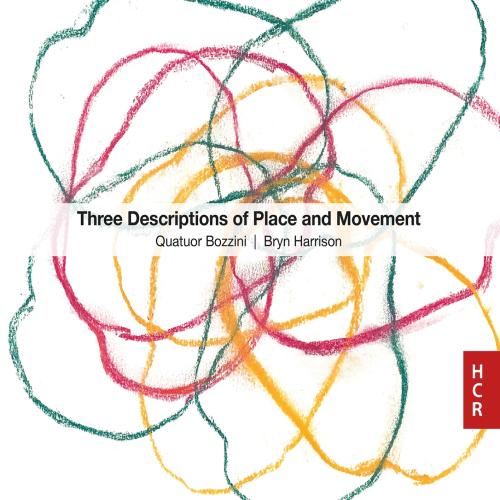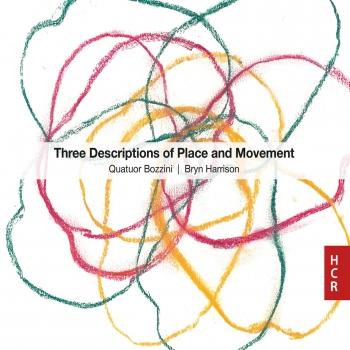
Bryn Harrison: Three Descriptions of Place and Movement Quatuor Bozzini
Album info
Album-Release:
2022
HRA-Release:
20.07.2022
Label: Huddersfield Contemporary Records
Genre: Classical
Subgenre: Chamber Music
Artist: Quatuor Bozzini
Composer: Bryn Harrison (1969)
Album including Album cover Booklet (PDF)
- Bryn Harrison (b. 1969): Three Descriptions of Place and Movement:
- 1 Harrison: Three Descriptions of Place and Movement: No. 1, Opening 05:04
- 2 Harrison: Three Descriptions of Place and Movement: No. 2, Clearing 23:11
- 3 Harrison: Three Descriptions of Place and Movement: No. 3, Burrow 33:35
Info for Bryn Harrison: Three Descriptions of Place and Movement
Following the success of their 2017–18 collaboration (Bozzini+, Piano Quintet, HCR19), the Bozzini Quartet is reunited with composer Bryn Harrison for Harrison’s first string quartet, the three-movement, hourlong Three Descriptions of Place and Movement (2021). A first string quartet is a landmark moment for any composer, but Harrison’s feels like a particularly significant arrival: the homogenous instrumentation is ideally suited to the disorienting labyrinthine structures, intricate repetitions, and extended durations that have characterised much of his recent work.
The title’s three ‘descriptions’ are clarified in the names of the movements. Opening, clearing, and burrow—all doubly verbs and nouns—are each embedded with simultaneous motion and stasis. Opening, an unfolding, widening, growing from a single point, as well as the aperture, the crevice, the window that frames the perception of space. Clearing, a kind of purging or scrubbing of materials down to their barren core, or a wide empty space, flat and nondescript, defined by the negative. And burrow, to carve deeper, to dig into, to bury oneself completely, or an underground cocoon, warm, enveloping, home.
Opening is constructed from a complex layering of information that obscures a rather simple harmonic motion: twin chromatic scales, one ascending, one descending, chasing each other in a wrapped double helix that opens, closes, and opens again. Tracing any one pattern, however, is instantly obfuscated by the displacement of successive pitches across octave and player, and by rhythmic patterns that control the speed at which each scale progresses.
After such intense concision and density, Clearing feels dangerously still. The same cross-hatched pitches, once buried by layers of complexity, are now laid bare at a permeating pianissimo. For nearly 25 minutes, the quartet enters in perfect rhythmic unison—two players at a time, six times a bar, at 63 beats per minute—unfolding the same spiral of pitches as before. Once the ear has grown accustomed to traceable consistency, Harrison introduces the first repeats in the work, catching the music mid phrase, insisting it revisit and review its pathways over and over again.
Burrow, the quartet’s final and longest movement, features the live quartet playing against two pre recorded versions of itself in canon, repeating the pitches and rhythms from opening verbatim but slowed now to half the original speed. Extensive repetitions, absent in opening, lodge the music further, and what was once a fleeting object becomes a fixated, rotating monolith stretching out in all directions.
"This is not music for the fainthearted, but for anyone with an interest in new music for string quartet, and in music that pushes the boundaries not just for performers but listeners too, this is an unusually captivating disc. Brilliantly recorded by James Clemens-Seely at Montreal’s Église St-Joseph de Rivière-des-Prairies in an acoustic that allows just the right amount of acoustic space around this experiment in time, and superbly performed by the Quatuor Bozzini, it’s a thoroughly recommendable album." (Europadisc)
Quatuor Bozzini
Quatuor Bozzini
Since 1999, Quatuor Bozzini has been an original voice in new, experimental and classical music. Their skew is radically contemporary, propelling the hyper-creative Montréal scene, and beyond. Not content to parlay received wisdom, the quartet cultivates an ethos of risk-taking, and boldly venture off the beaten track. With rigorous qualitative criteria, they have nurtured a vastly diverse repertoire, unbiased by the currents of fashion. This has led to close to two hundred commissioned pieces, as well as over three hundred premiered works. A Quatuor Bozzini concert is an intensely shared experience, with meticulous and sensuous attention to detail.
Praised by its “intense musicality and immense sensitivity” (Musicworks, Canada), Quatuor Bozzini was qualified in the Bandcamp Daily as “one of the most daring string quartets of the entire world.” The group presents an annual concert series in Montréal and also tours extensively in Canada, the USA, South America and Europe. Notable festivals and venues include MaerzMusik (Berlin), Ultima (Oslo), Huddersfield (UK), Klangspuren (Austria), Tsuda Hall (Tokyo), Musiekgebouw (Amsterdam), November Music (Netherlands), Présences (France), Kortrijk (Belgium), TimeSpans (NYC), Porgy&Bess (Vienna) and Other Minds (San Francisco). To ensure continual development in their art, the quartet’s musical laboratories, the Composer’s Kitchen, Performer’s Kitchen and Bozzini Lab, work to mentor and support new generations of composers and performers. The quartet runs its own recording label, Collection QB, and has issued critically acclaimed albums, many of which have become reference recordings in the discipline. They also have issued albums with Edition Wandelweiser, Another Timbre, Wergo-Deutscher Musikrat, Centrediscs and ATMA Classique.
In 2018, Quatuor Bozzini was awarded the Prix Opus — Performer of the Year by the Conseil québécois de la musique. Finalist to the 28th Grand Prix (Conseil des arts de Montréal, 2012), Quatuor Bozzini is also the recipient of three Opus Prizes “International Outreach” (2007), “Contemporary Disc of the Year” (2004), and “Discovery of the Year” (2001) as well as the Étoile-Galaxie Prize from Radio-Canada (2001), the Förderpreis Ernst von Siemens Musikstiftung (2007), the German Record Critics Prize for Arbor Vitae (2009) and the 2014 Friends of Canadian Music Award.
Booklet for Bryn Harrison: Three Descriptions of Place and Movement









